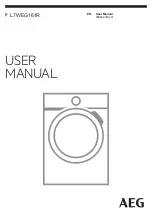
Summary of Important Safety Information
58
Installation / Initial Set-up
•
Level, heat-resistant surface
. Situate pressure washer on a firm, level, and heat-resistant surface with good drainage.
Ensure it sits level and will not slide or shift during operation. Block wheels to prevent movement.
•
Prevent carbon monoxide poisoning
–
Use outside only!
Exhaust fumes from both the engine and the burner contain
carbon monoxide (CO), a poisonous gas you cannot see, smell, or taste. The CO generated by the pressure washer can
rapidly accumulate, even in areas that appear to be well ventilated, resulting in dangerous and fatal concentrations within
minutes. To prevent dangerous CO build-up:
•
ONLY use pressure washer outdoors and at least 20 feet from the home, away from windows, vents and air
intakes, to allow proper ventilation. If you start to feel sick, dizzy, or weak while using the pressure washer, shut
off the engine and get to fresh air RIGHT AWAY.
•
NEVER run pressure washer in an enclosed or partially enclosed location such as a building, garage, shed, or
vehicle. Running a fan or opening windows will not provide adequate ventilation to prevent dangerous CO build-
up.
•
Adequate ventilation
. The pressure washer needs adequate, unobstructed flow of air to allow for proper combustion
and cooling. Situate so there is adequate clearance around pressure washer to allow for airflow
–
at least 7' from any
non-combustible wall or obstruction. Never place any objects against or on top of pressure washer.
•
CO alarms
. Ensure that working, battery-operated or battery back-up carbon monoxide alarms are used in any
dwelling/structure that is in close proximity to the running pressure washer.
•
Hot exhaust - fires
. Exhausts from engine and burner can be extremely hot and cause fire. Position sprayer so engine
and burner exhausts are at least 7' away from combustible objects during operation.
•
Spark arrestor usage
. Equip engine with a spark arrestor if pressure washer will be used near any ignitable forest,
brush, or grassy land. See the "Specifications" section of this manual to determine if your pressure washer is already
equipped. In such conditions, make sure you comply with applicable local, state and federal codes.
Fuel Safety
Gasoline is highly flammable and explosive; and burner fuels are combustible at warm temperatures. You can be burned or
seriously injured when handling fuel. Using extreme care when handling fuel, including these preventative measures:
•
Fuel outdoors
. Fill fuel tank outdoors
–
never indoors. Fuel vapors can ignite if they collect inside an enclosure.
Explosion can result.
•
Use approved container
. Never pump fuel directly into fuel tank at gas station. Static charge can build and ignite fuel.
Use an UL approved fuel container to transfer fuel to the engine.
•
Running / hot engine
. A hot engine or burner is hot enough to ignite fuel. Never add fuel or remove fuel cap if engine
or burner are running or still hot. Allow engine to cool at least two minutes before adding fuel.
•
Heat / flames / sparks
. Stay away from sources of heat, flame, or sparks while adding fuel.
•
Don't overfill
. DO NOT overfill the fuel tank. Allow at least 1/2" of empty space below the fill neck to allow for fuel
expansion.
•
Replace cap
. Replace fuel cap securely before starting engine.
•
Spills
. Clean up fuel spills immediately. Move pressure washer away from spilled fuel on the ground. Wipe fuel off
engine and wait 5 minutes for excess fuel to evaporate before starting engine. Fuel soaked rags should be disposed of
properly.
•
On skin / clothes
. If fuel is spilled on your skin or clothes, change clothes and wash skin immediately.
•
Inspect fuel system
. Check fuel tanks and fuel system on a regular basis. Look for signs of leaks, deterioration, chafed
or spongy fuel hose, loose or missing fuel hose clamps, damaged fuel tank, or a defective fuel shut-off valve. Do not
start pressure washer until needed repairs have been completed.
•
Fuel storage
. Store fuel in a cool, dry place in an UL-approved, tightly sealed container.
Safety
–
Towing
•
Maintain trailer for safe operation.
Follow all instructions to make sure the trailer is in good working order and tires
are fully inflated in order to prevent loss of control while towing.
•
Hitch trailer properly.
Follow all instructions for hitching trailer to towing vehicle. Make sure hitched trailer sits
level
•
Jack.
Keep jack cranked down to help balance the trailer when it is not connected to a vehicle hitch. Crank jack up
before towing.
•
Read vehicle instructions
. Review towing safety instructions in your towing vehicle manual.
•
Driving skills.
Special attention and driving skills are needed for towing any type of trailer.
Содержание 157595
Страница 51: ...Parts Explosion 157595 Rev BK 51...
Страница 53: ...Parts Explosion 157595 Rev BK 53...
Страница 55: ...Pump Explosion Rev BK 55...
Страница 56: ...Wiring Diagram Rev BK 56...
Страница 62: ...62 This page has intentionally been left blank...







































